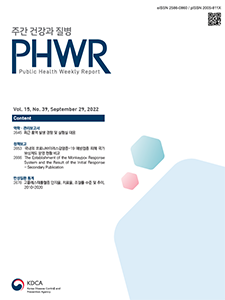Current Issue
Vol.15 No.39, September 29, 2022
-
Epidemiology and Surveillance 2022-09-29
 0
0
 1154
1154
 290
290
Incidence of Measles in Korea and Laboratory Response against Outbreak
Su Jin Kim, Eun-Ji Choi, Deog-Yong Lee, Myung-Guk Han*
Public Health Weekly Report 2022; 15(39): 2645-2652 https://doi.org/10.56786/PHWR.2022.15.39.2645 Abstract
AbstractMeasles is classified as a category 2 and notifiable infectious disease in Korea. Measles vaccination began in 1965 in Korea, and its prevalence has decreased extensively. Korea was certified as a World Health Organization measles-free country in 2014, and several conditions must be met to maintain this status. First, it is essential to monitor the incidence of domestic cases. In the event of an outbreak, it is necessary to distinguish infections caused by domestic and imported viruses. For this purpose, molecular and genetic analyses of the measles virus are required. The genotype of the measles virus is based on the nucleotide sequence of the N gene. The genetic diversity of the measles virus is decreasing with the decreasing prevalence of measles globally. For some cases, similar results can be obtained with genetic homology, even though there is no dynamic relationship between the geographic and temporal occurrences, due to the decreased diversity of N genes. Therefore, it is difficult to analyze the epidemiologic characteristics of the measles virus only with the currently used molecular genetic method (N450) for the N gene, and various efforts are being made to improve it. Among the analysis methods being improved, M-F NCR gene sequencing is considered a promising replacement for the measles virus whole genome sequencing (WGS) because it selects a region with relatively high genetic diversity. Accordingly, the Korea Disease Control and Prevention Agency has established the M-F NCR gene analysis method and is using it. In the future, it will be possible to identify the origin of the measles virus quickly and accurately by applying the established M-F NCR gene analysis method.
-
Policy Notes 2022-09-29
 1
1
 129
129
 52
52
A Comparison of the Implementation of National COVID-19 Vaccine Injury Compensation System
Jonghee Kim*, Yeonsung Yoo, Eunok Bahng, Sunghee Kim
Public Health Weekly Report 2022; 15(39): 2653-2665 https://doi.org/10.56786/PHWR.2022.15.39.2653
In this study, we compared and analyzed the current status of the global compensation systems for COVID-19 vaccination. Although we have a relatively short history of compensation system, eligibility of claim, financial coverage, and approval of compensation were wider than those of other advanced countries. In addition, medical expenses and death compensation for insufficient evidence are considerable to extensive financial support. However, considering of necessity for improvement in administration on the division of tasks needs to be proceed.
-
Noncommunicable Disease Statistics 2022-09-29
 0
0
 2102
2102
 542
542
Awareness, Treatment, and Control of Hypercholesterolemia, 2010–2020
Public Health Weekly Report 2022; 15(39): 2678-2679 https://doi.org/10.56786/PHWR.2022.15.39.2678

pp. 1433~1461
Most Keyword
?
What is Most Keyword?
- It is the most frequently used keyword in articles in this journal for the past two years.
Most Read
-
Waterborne and Foodborne Disease Outbreaks in the Republic of Korea, 2023
Myung-Jae Hwang, So Yeon Park, Hyungjun Kim, Se Jeong Yang, Sungchan Yang, Jin Seon Yang
Public Health Weekly Report 2025;18: 17-32 https://doi.org/10.56786/PHWR.2025.18.1.2 -
Implementation Plan for the Coronavirus Disease 2019 Vaccination for the 2024–2025 Season: Recommendations of the 6th Expert Committee on Immunization Practices
Hyewook Hwang, Wookeon Lee, Seohyeon Ahn, Young-Sook Choi, Seunghyun Lewis Kwon, Dongwoo Lee, Eun Hwa Choi, SokGoo Lee
Public Health Weekly Report 2025;18: 90-102 https://doi.org/10.56786/PHWR.2025.18.2.3
Editorial Office
+82-43-719-7569





 Full Text
Full Text Cite
Cite


